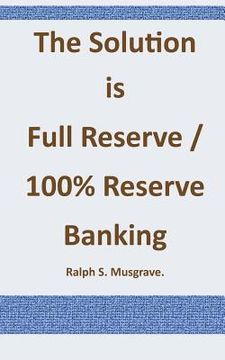Reseña del libro "The Solution is Full Reserve / 100% Reserve Banking (en Inglés)"
The banking crisis and recession which started around 2007 and the astronomic amounts of public money used to bail out banks made it obvious that there was something seriously wrong with the banking system. This was very much a repeat of the 1929 crash and subsequent bank failures and recession. One response in the 1930s was the promotion of full reserve or "100% reserve" banking particularly by economists at the University of Chicago. However, full reserve banking while it benefits ordinary households and the economy as a whole does not benefit banks or the politicians funded by banks. That is, as Milton Friedman pointed out, full reserve (FR) tends to be opposed by vested interests. And in the 1930s, the vested interests won. However, the 2007 crisis caused a re-consideration of FR, and this book sets out the arguments for it. One merit of FR is its simplicity. It is certainly simple compared to other attempts at bank reform taking place at the time of writing, e.g. Dodd-Frank in the US or the Vickers proposals in the UK. Essentially FR consists of splitting the banking industry in two. One half is for those who want specific sums of money kept in a totally safe fashion. That money is not safe because of any sort of artificial taxpayer funded subsidy or guarantee, which is how bank accounts are currently made safe. The money is safe because it is INHERENTLY safe: that is, the money is just lodged at the central banks and/or it is invested in short term government debt. The second half offers loans to mortgagors, businesses and so on, but that half is funded just by shares, not by deposits which banks claim to be entirely safe (but which clearly are not entirely safe unless they are backed by artificial taxpayer funded guarantees). One of the many advantages of full reserve is that it is near impossible for the entities or banks making up those two halves to suddenly fail, and thus spark off credit crunches or recessions. Though given poor management, any of those entities can slowly decline, resulting perhaps in a take-over by more competent entities / banks. Also FR banking does not require any sort of subsidy, plus there needn't be any limit the amount of money that any individual can lodge in a totally safe fashion, that limit being 85,000 at the time of writing in the UK. FR results in, 1 less borrowing and lending, 2 a rise in interest rates, and 3 a decline in debts. However, that rise in interest rates would be small compared to the HUGE VARIATIONS in interest rates over the last thirty years or so. Moreover, in the UK, the size of the banking industry relative to GDP is currently about TEN TIMES the 1960s level, and it is unclear what benefits we derive from that bloated banking industry. Thus the slight contraction in the banking industry that would occur under FR would probably do no harm. This book is split into three sections. Section one sets out the basic nature of FR. Section two deals with the very large number of objections which have been made against FR. Most of these objections, even though they are put by so called professional economists, are very silly. No knowledge of economics is needed to rebut them: just common sense. In contrast, some objections are more plausible, though actually flawed. But that is not to say that the ADVOCATES of FR are perfect: section three of the book deals with some popular but flawed arguments put FOR full reserve. A final and interesting characteristic of FR is thus. Under the existing system, the large majority of money in circulation originates with commercial banks, not government or the central bank. In contrast, under FR all money is issued by the central bank. There has actually been a huge rise in the proportion of our money supply originating with central banks as a result of quantitative easing in recent years. That does not seem to have caused big problems.

